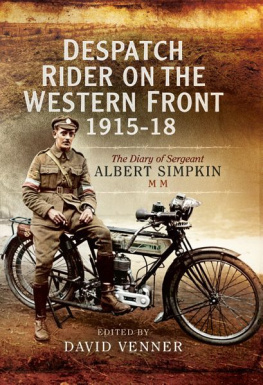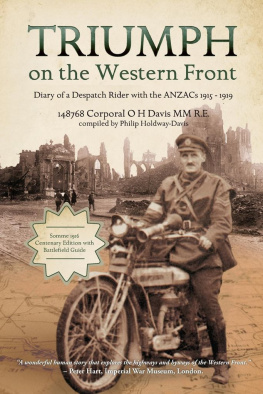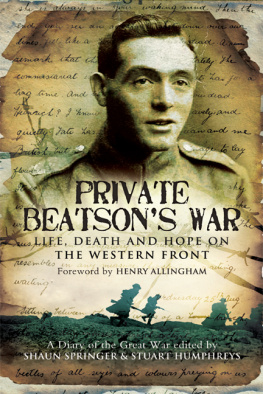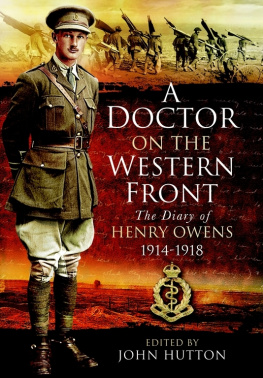To the memory of my mother,
Marguerite Elizabeth Venner
(1919-2014)
for her unconditional
love and support
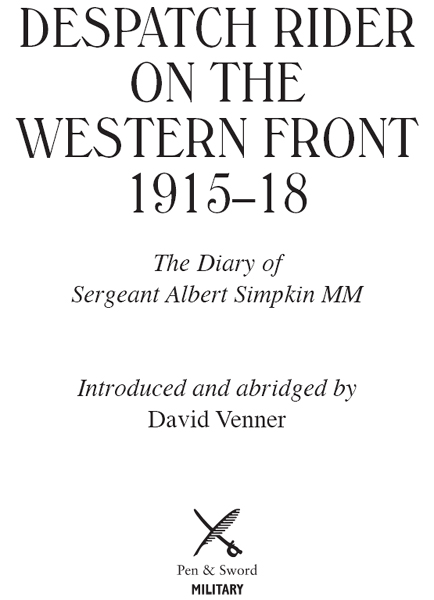
First published in 2015 by
Pen and Sword Military
An imprint of
Pen & Sword Books Ltd
47 Church Street
Barnsley
South Yorkshire
S70 2AS
Copyright David Venner, 2015
ISBN: 978 1 47382 740 0
EPUB ISBN: 978 1 47385 967 8
PRC ISBN: 978 1 47385 966 1
The right of David Venner to be identified as Editor of this work has been asserted
by him in accordance with the Copyright, Designs and Patents Act 1988.
A CIP catalogue record for this book is
available from the British Library
All rights reserved. No part of this book may be reproduced or transmitted in
any form or by any means, electronic or mechanical including photocopying,
recording or by any information storage and retrieval system, without
permission from the Publisher in writing.
Printed and bound in England
By CPI Group (UK) Ltd, Croydon, CR0 4YY
Pen & Sword Books Ltd incorporates the Imprints of Pen & Sword Aviation,
Pen & Sword Family History, Pen & Sword Maritime, Pen & Sword Military,
Pen & Sword Discovery, Pen & Sword Politics, Pen & Sword Atlas, Pen & Sword
Archaeology, Wharncliffe Local History, Wharncliffe True Crime, Wharncliffe
Transport, Pen & Sword Select, Pen & Sword Military Classics, Leo Cooper, The
Praetorian Press, Claymore Press, Remember When, Seaforth Publishing and
Frontline Publishing
For a complete list of Pen & Sword titles please contact
PEN & SWORD BOOKS LIMITED
47 Church Street, Barnsley, South Yorkshire, S70 2AS, England
E-mail:
Website: www.pen-and-sword.co.uk
Contents
by David Venner
by Albert Simpkin, MM
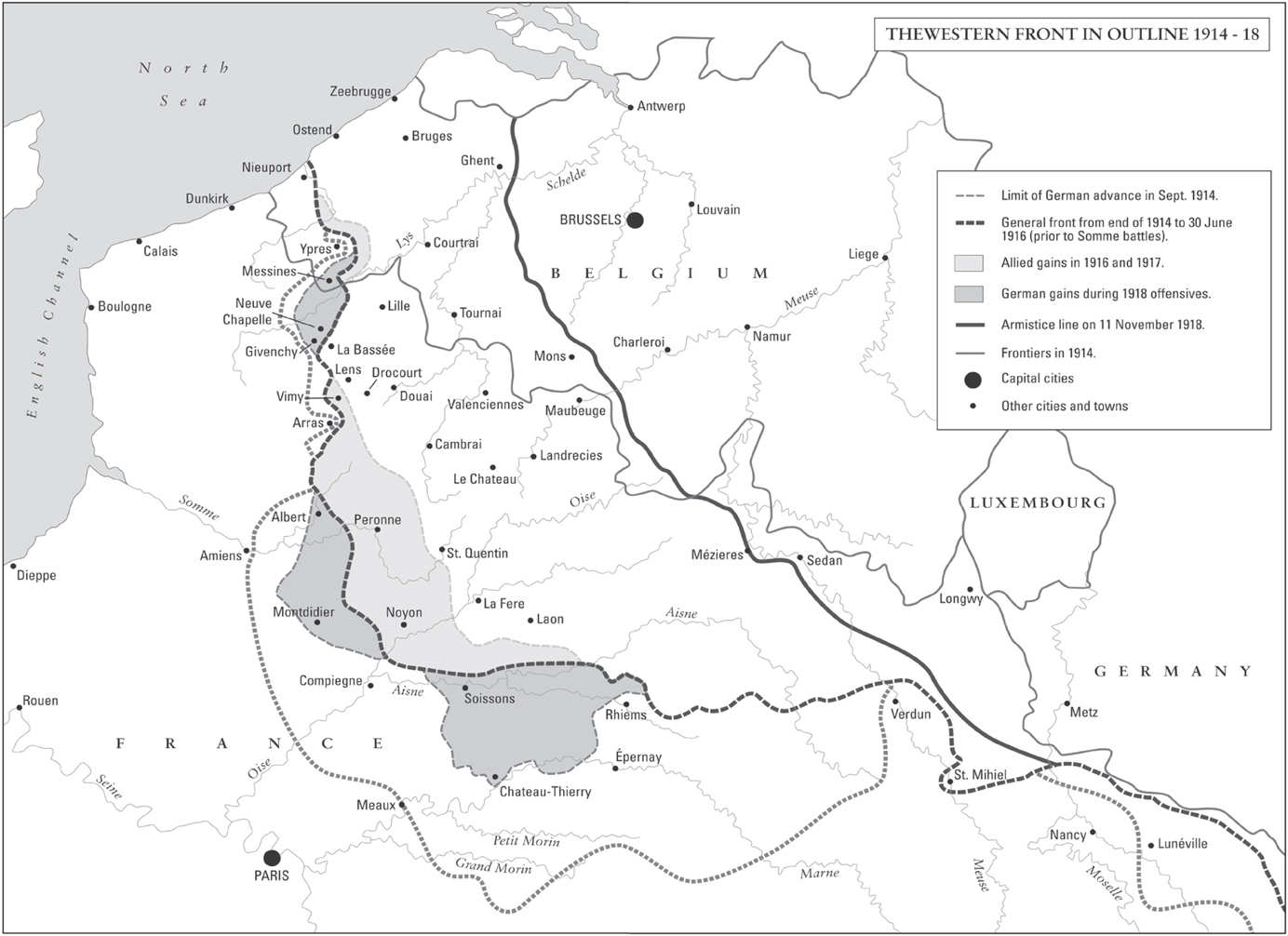
ACKNOWLEDGEMENTS
I would like to acknowledge the help, advice and support that I have received from many people in the preparation of this diary for publication.
The staff at the Imperial War Museum in Lambeth and The National Archives at Kew guided my searches for personal and unit war diaries and other background material that helped bring a non-specialist up to speed on First World War matters. Staff at the Manchester, Salford and Stockport Libraries and at the Museum of Science and Industry in Manchester, helped me piece together Albert Simpkins early life and work in the North-west.
Steve Jackson of the Triumph Owners Motorcycle Club, and Martin Gegg of the Warbike Project, patiently answered my questions on early motorcycles - another subject about which I previously knew very little.
Brigadier Henry Wilson at Pen and Sword Books recognised the quality of Albert Simpkins writing and encouraged me to abridge the diary to a publishable length; and I am grateful to all the design, marketing and production people at Pen and Sword for their courtesy and professionalism in an exceptionally busy time for First World War publishing.
Sarah Escott of The Best of Barnstaple guided me through the social media maze and Suzie Grogan, researcher and author of Shell Shocked Britain, offered encouragement and support.
My dear, long-suffering wife Sue Williamson has had to put up with cluttering and tweeting and other distractions from normal family life. She, my daughter Rosie and son Jamie also read early versions of the abridged diary and made helpful comments.
I owe a huge debt of gratitude to Albert Simpkin himself. Not only did he endure the many hardships of the Western Front for nearly four years, but also had the presence of mind to record his experiences, cryptically at first and then more expansively. He made my task of abridging and editing the typescript far less laborious than it might have been. I can only hope that he would not have been too upset to see 45,000 of his carefully crafted words end up on my study floor! (For those who wish to read the unabridged version it can be viewed, by appointment, at the Imperial War Museum in London.)
The photographs reproduced in this book are from Albert Simpkins contemporary collection or were taken by his wife Lily on their visit to the battlefields in 1938.
Finally, thanks are due to my late mother, Marguerite Elizabeth Venner, who brought the original diary back to England after Alberts death in Buenos Aires and encouraged me to get it published. Sadly she did not live quite long enough to see the finished product but I hope that she and her uncle Albert - would have approved.
David Venner
High Bickington
April 2015
INTRODUCTION
The First World War diary of Sergeant Simpkin came to my notice in 1982 following the death of his widow in Buenos Aires. Another war, between Britain and Argentina over the Falklands, inconveniently started while my mother (their niece) was in Buenos Aires to wind up her estate. The Argentine authorities blocked the transfer of bank balances and other parts of the estate to the UK. All my mother could bring out of the country were some small valuables that could be secreted in her suitcases, together with this diary which was in the form of a bundle of typewritten sheets tied together with string.
A hand-written note stapled to the sheets read:
This book describes the many actions and the wanderings of the 37th Division in France from July 1915 to the Armistice in November 1918. The author, a sergeant in the infantry, by a miracle survived without serious injury. The writer of these notes served as a despatch rider attached to the 37th Division HQ and took part in all the actions mentioned.
This strongly suggests that publication was in his mind, although it is not clear why he did not pursue the plan. His typescript runs to nearly 500 pages and contains around 130,000 words. Perhaps then as now it was considered to be too long for publication in full. The present volume is an abridged version of the diary, prepared by the authors great nephew.
The entries selected for inclusion provide a fascinating record of the life of a despatch rider on the Western Front: one day dodging shell holes and ammunition limbers to take his despatches to the front, the next observing the quaint but often courageous lives of the local populace. Throughout the diary are colourful and amusing anecdotes about his fellow soldiers, and critical comments on the strategies and tactics employed by the officers.
As an engineer in his pre-war civilian job, Albert took a particular interest in the products of army mechanisation. So when the first tanks and newly-developed aircraft appear in the battle zone, he has some insightful comments to make on their design and effectiveness or otherwise.
Some of the original entries, covering the main actions of the 37th Division, are much longer passages that go beyond the usual diary form. These cover the battles of the Somme (July 1916), the Ancre (November 1916), Arras (April 1917), and Ypres (the third battle in August 1917). Also described in detail are the German offensive of April 1918, the final Allied offensive in August 1918 and the Armistice. These passages are included as narratives alongside the selected diary entries.
THE DIARIST
Albert Edward Simpkin was born at Salford near Manchester, on 28 June 1885, the eldest child of Walter and Hannah Simpkin. Walter, a printer by trade, was originally from Loughborough but had moved to Salford soon after his marriage. After Albert came a daughter Gertrude and a son Frank. In 1897, when Albert was 12-years-old, Hannah died during the birth of another daughter, Elsie. She was just 39-years-old. Walter, with four young children to look after, soon re-married and two further children were born.
Next page
